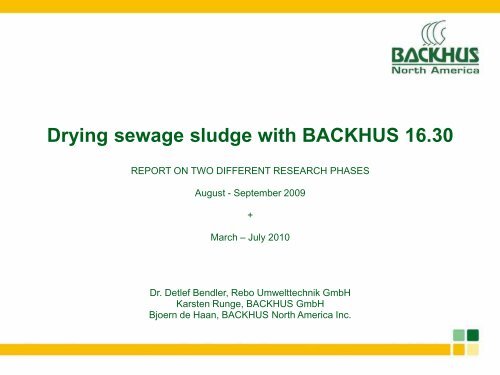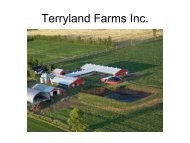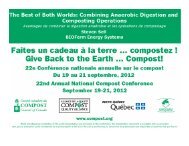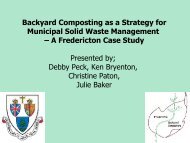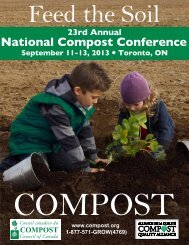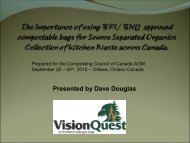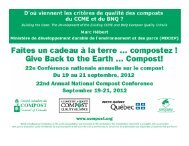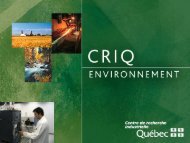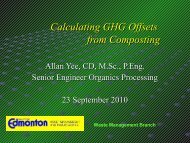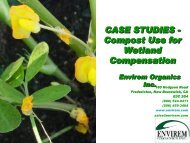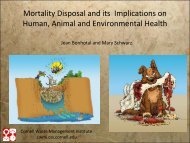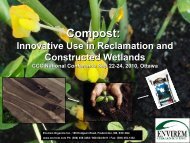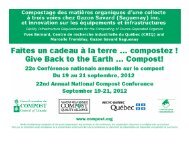Bjoern de Haan, BACKHUS North America
Bjoern de Haan, BACKHUS North America
Bjoern de Haan, BACKHUS North America
- No tags were found...
Create successful ePaper yourself
Turn your PDF publications into a flip-book with our unique Google optimized e-Paper software.
Drying sewage sludge with <strong>BACKHUS</strong> 16.30REPORT ON TWO DIFFERENT RESEARCH PHASESAugust - September 2009+March – July 2010Dr. Detlef Bendler, Rebo Umwelttechnik GmbHKarsten Runge, <strong>BACKHUS</strong> GmbH<strong>Bjoern</strong> <strong>de</strong> <strong>Haan</strong>, <strong>BACKHUS</strong> <strong>North</strong> <strong>America</strong> Inc.
WHY DRYING?- The heating value of dry sludge equates roughly the value of brown coal- Cement plants for instance uses this material as an alternate fuel toamend its CO2 balance- Sludge is rated as an non-fossil fuel- To avoid land application
SOLAR SEWAGE SLUDGE METHODSEstimated market size: about 100 facilities worldwi<strong>de</strong> per yearSimilar systems on the market – for instance:Thermo-System GmbHwww.thermo-system.comTurner: „The electric pig“Batch operated systemIST Anlagenbau GmbHwww.ist-anlagenbau.<strong>de</strong>Turner: „The turning wolf“Flow through operated system
GOALS OF 1 st RESEARCH PHASE1. Testing sewage sludge drying with windrow composting method2. Influence on material of different turning frequencies and cover methods3. To <strong>de</strong>termine the necessary processing time for a maximum drying effect4. Rough estimation on required size for the facility
JULY 07 th 2009 INSTALLATION OF A STRUCTURE BUILDINGOpen si<strong>de</strong>s to achieve a wind flow and additional drying effectSimilar to a green house
DELIVERY OF <strong>BACKHUS</strong> 16.30 TURNERDATA:Windrow dimension:9.9’ x 4.3’Capacity:Up to 980 yd3/hourDiesel engine:47.5 HP YANMARDrive System:HydraulicSelf-propelled:On tracksWeight:1.7 tones
FIRST DELIVERY OF SEWAGE SLUDGEProvi<strong>de</strong>d by aregional wastewater treatmentplant.
START OF 1 st RESEARCH PHASESUMMER/FALL WEATHER CONDITIONS (75 -85 F)FIRST TURNING WITH A <strong>BACKHUS</strong> 16.30 TURNER• Two (2) windrows un<strong>de</strong>r roof (Z1 & Z2)• Two (2) windrows covered with compost fleece (A1 & A2)• Two (2) windrows outdoor (F1 & F2)Dry Matter content in material: 22%
TURNING FREQUENCYWindrow Z1: un<strong>de</strong>r roof, turning frequency once per week (M)Windrow Z2: un<strong>de</strong>r roof, turning frequency twice per week (M + F)Windrow A1: covered withToptex fleece, turning frequency once per week (M)Windrow A2: covered withToptex fleece, turning frequency twice per week (M + F)Windrow F1: open windrow, turning frequency once per week (M)Windrow F2: open windrow, turning frequency twice per week (M + F)Windrow 0: open windrow, no treatment
DAY 5 OF 1 st RESEARCH PHASE – 2 nd TURNINGBefore turningAfter turningNO SIGNIFCANTDIFFERENCES
Day 11 OF 1 stRESEARCH PHASEBefore turningAfter turningDM CONTENT:UP TO 27%TEMPERATURE:UP TO 95 F
Day 18 OF 1 st RESEARCH PHASESteam reactionDM CONTENT: UP TO 40%TEMPERATURE: UP TO 122 F
INTERMEDIATE RESULTS DAY 19- Minor temperature increases in most windrows (average 86 F)- Windrow Z2 (indoor, twice a week) with 103 F was the exception- No difference between F2 (open, twice) and A2 (cover, twice) visibleIn or<strong>de</strong>r to push on the drying process we <strong>de</strong>ci<strong>de</strong>d to increase theturning frequency on A2, F2 and Z2 to three times a week.
Day 28 OF 1 st RESEARCH PHASEDRY MATTER CONTENT: UP TO 60%TEMPERATURE: UP TO 122 F
END OF 1 st RESEARCH PHASE AFTER 58 DAYSFINAL DM CONTENT WAS 80%
RESULTS OF 1st RESEARCH PHASEConsi<strong>de</strong>rable difference of Z2to all other windrows0 – No treatmentF1 – OutdoorF2 – OutdoorA1 – FleeceA2 – FleeceZ1- IndoorZ2- Indoor
COMPOST FLEECE IS NOT NECESSARYDue to missing wind and sun dryingwe noticed the worst result inwindrow A2 which was covered withfleece.DM content during the trial period (Z = shed, F = outdoor, A = with compost fleece)
FREQUENT TURNINGMore frequent turning is theway to increase the DMcontent – Here roughly 15%F1/F2 Outsi<strong>de</strong> windrows
AREA CONSUMPTION WITH <strong>BACKHUS</strong> 16.30:Precondition:pre <strong>de</strong>watered sludge > 20 % dry solids contentprocessing target up to 80 % dry solids contentNee<strong>de</strong>d processing time:up to 8 weeksProcessing cycles per year: 52 / 8 = 6,5Area occupation by <strong>BACKHUS</strong> 16.30:Possible throughput capacity:Capacity of the competition:up to 0,9 yd³/yd²up to 6,5 * 0,7 = 5,85 yd³/yd² per yearup to 4 yd³/yd²Other manufacturer lay the material out with a height of 1 foot. Larger area is required.
CONCLUSION OF 1st RESEARCH PHASEDrying of sewage sludge with using the biological energy of the organic part of the sludge incombination with sun and wind effects, but without using any additional energy source can beachieved by using simple windrow technology.Process improvements can be achieved by:• More frequent turning• To roof the windrows with a simple shed (i.e. a greenhouse)
GOALS OF 2 ndRESEARCH PHASE- Repeat of drying tests un<strong>de</strong>r Winter/Spring conditions- Impact study of drying while constant adding of fresh sludgeSET UP 1st TRIAL:Same shed as in Summer test 2009.Windrow 1: Fresh sludge with a DM content of 17.6 %Windrow 2: Dried sludge, already stored for a while
START MARCH 9, 2010Outsi<strong>de</strong>temperature 37 F
April 8, 2010 - FIRST ADDING OF FRESH SLUDGEINTO WINDROW 1Temperatures: Windrow 2 = 55 F, Windrow 1 = 133 F, Outsi<strong>de</strong> temperature = 44 F
AFTER 4th ADDING OF FRESH SLUDGETemperatureWindrow 1 = 89 FOutsi<strong>de</strong>Temperature = 48 F
TEMPERATURE PROFIL FIRST TRIAL706050Temperatur in C4030201004 addings into windrow 1, 28 turnings in 12 weeksLuft Miete 1 Miete 2 Zugabe Miete 1 Umsetzen
CONCLUSION OF FIRST TRIALMarch 9th to May 28th 2010- Un<strong>de</strong>r given weather circumstances we noticed a significant longer process time- The time frame to achieve an effective drying and a necessary temperature of more than 105 F isthree weeks for already pre-treated material and six weeks for fresh material with a DM content of18%- After achievement of temperatures higher than 122 F we were able to add fresh sludge.Every seven to ten days we ad<strong>de</strong>d 25-50% of fresh material into that excisting windrow without goingun<strong>de</strong>r a temperature of 85 F which would stop the drying processPLANNING OF SECOND TRIAL:Based on the results of our first trial we <strong>de</strong>ci<strong>de</strong>d to have another trial which will show how much theprocess <strong>de</strong>pends on different amounts of adding material.
SECOND TRIALJune 1st to July 28, 2010We used the material of our first trial and mixed it 1:1 with fresh sludge and built two new windrows withfollowing plan:Windrow 1: Adding one big amount of fresh sludge once per weekWindrow 2: Adding smaller amounts of fresh sludge three times per weekAdding amounts:Windrow 1: roughly 30 % of original windrow volume once per weekWindrow 2: roughly 45 % of original windrow volume. Ad<strong>de</strong>d on three days per weekTurning frequency:Both windrows three times per week at the same day.In o<strong>de</strong>r to have a all-over control of temperature we used a diagnostic <strong>de</strong>vice which logged thetemperature every 20 minutes
TEMPERATURE PROFIL SECOND TRIAL6050Temperatur in C40302010001/06/201002/06/201003/06/201004/06/201005/06/201006/06/201007/06/201008/06/201009/06/201010/06/201011/06/201012/06/201013/06/201014/06/201015/06/201016/06/201017/06/201018/06/201019/06/201020/06/201021/06/201022/06/201023/06/201024/06/201025/06/201026/06/201027/06/201028/06/201029/06/201030/06/201001/07/201002/07/201003/07/201004/07/201005/07/201006/07/201007/07/201008/07/201009/07/201010/07/201011/07/201012/07/201013/07/201014/07/201015/07/201016/07/201017/07/201018/07/201019/07/201020/07/201021/07/201022/07/201023/07/2010Luft Miete 1 Miete 2 Zugabe Miete 1 Zugabe Miete 2 Umsetzen
FINAL MATERIAL – DM CONTENT 66,7 %
FINAL MATERIAL– DM CONTENT 71,0 %
SUMMARY OF 1st AND 2nd RESEARCH PHASEBASIC DATAWindrow: Length: 50ftWidth:8,2ftHeight:2,3ftVolume:17.46yd³Bucket: Volume: 0,9yd³Mass balance: Date Windrow 1 Windrow 2 Windrow Z2*Fresh material: 50% 06.01.2010 8.73 8.73 17.46 yd³Pre-dried material: 50% 06.01.2010 8.73 8.73 yd³06.09.2010 3 6 Buckets06.11.2010 3 Buckets06.14.2010 3 Buckets06.16.2010 3 6 Buckets06.18.2010 3 Buckets06.21.2010 3 Buckets06.23.2010 3 6 Buckets* Windrow Z2 from August 2009Gesamt: 36.36 33,66 17.46 yd³
SUMMARY OF 1st AND 2nd RESEARCH PHASEMoisture BalanceFresh amount: Windrow 1 Windrow 2 Windrow Z2/1 * Windrow Z2/2 *36.36 33.66 17.46 17.46 yd³ = tDM content fresh material: 18% 18% 22% 22%DM pre-dried material **: 40% 40% - -+ 15 %Initial DM content: 29% 29% 22% 22%Final DM content: 67% 71% 67% 71%Process time: 56 56 36 41 DaysMoisture reduction: 0,67 0,75 1,24 1,20 %/dayEvaporation: 49.40 51 43.06 41.47 Gal/dayAbsolute moisture reduction: 2,771.16 2,854.37 1,549.89 1,698.89 Gal over entire process timeSpecific moisture reduction: 99.59 110.95 118.08 129.44 Gal/yd³ fresh materialSpecific evaporation : 1.77 1.98 3.28 3.15 Gal/yd³ fresh material per day* Windrow Z2 from August 2009, final moisture interpolated** from August 2009 interpolated
CONCLUSIONDrying of sewage sludge with a DM of 18% without adding structure material is even possible un<strong>de</strong>r winterweather conditions. However the <strong>de</strong>mand of time to achieve a temperature of 122 F is almost doublecompared to summer conditions.The adding of fresh sludge at frequent intervals of seven to ten days to windrows with a temperature ofmore than 105 F is possible without having interruptions in the drying process.The adding of smaller amounts of sludge does not have any better influence on the process. We found thatthat the process with an adding of a bigger amounts once per weeks brings the best result.With continuous adding of fresh sludge during drying process the specific drying result can be upto 15% better compared to a process without adding.
Thank you for yourattention!


